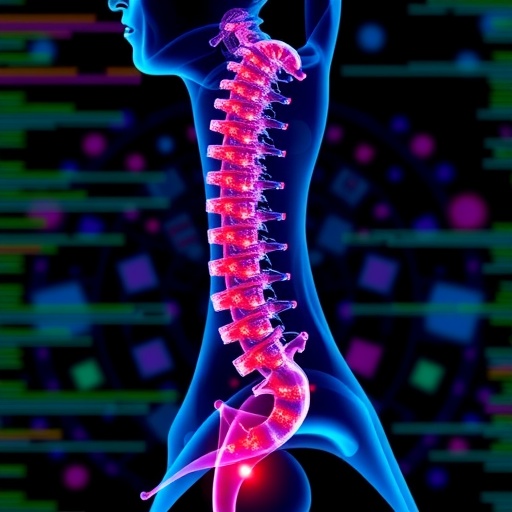Spinal cord injury (SCI) continues to represent one of the most daunting medical challenges, often leaving patients with irreversible paralysis and profound disability. The complexity of SCI lies in the nervous system’s limited capacity for regeneration, where neurons within the brain and spinal cord fail to efficiently regrow after injury. Recent groundbreaking research conducted by scientists at the University of California San Diego (UCSD) School of Medicine has leveraged sophisticated bioinformatics tools to accelerate the search for a promising therapeutic candidate that may change the trajectory of SCI treatment.
At the cellular level, the inability of central nervous system neurons to regenerate is a fundamental barrier to recovery following spinal cord trauma. Neurons in the peripheral nervous system exhibit a greater regenerative potential, but the central nervous system, which includes the brain and spinal cord, is markedly restrained in this capacity. To overcome this, researchers examined gene expression profiles from mouse neurons under experimental conditions that promoted regenerative processes. They discovered a distinct transcriptional signature—a pattern of gene activation—linked directly to neuronal growth and repair mechanisms.
Building on this crucial discovery, the team employed highly advanced computational bioinformatics approaches involving data mining against extensive molecular databases. This enabled the researchers to cross-reference the gene expression profile indicative of neuronal regeneration with a wide array of bioactive compounds. Their objective was to pinpoint drugs capable of inducing a comparable gene activation pattern, thereby potentially stimulating neuronal regrowth in injured spinal cords. This systematic screening yielded Thiorphan, a drug previously evaluated in human clinical trials for conditions unrelated to neurology, as a top candidate due to its ability to recapitulate the regenerative gene expression signature.
A particularly notable technical leap in this study was the successful culture of adult human brain cells, which historically have been incredibly challenging to grow in vitro due to their fragility and complex microenvironmental requirements. By cultivating these cells, the researchers directly tested Thiorphan’s efficacy in human neural tissue. They observed significant increases in neurite outgrowth—the extension of axons and dendrites critical for neural network reformation—highlighting Thiorphan’s regenerative potential in adult human neurons in a lab setting. This development represents a methodological breakthrough, offering a robust platform for future neurological drug discovery.
The investigation extended beyond cellular models into in vivo testing using a rat model of SCI. When administered alone, Thiorphan elicited a 50% improvement in the recovery of fine motor function in the animals’ forelimbs, demonstrating functional neurological benefit. Remarkably, when combined with the transplantation of neural stem cell grafts, the motor function improvement doubled, indicating a synergistic effect. The intervention not only enhanced behavioral outcomes but also facilitated increased regeneration of neurons into the injury site, offering anatomical evidence for the restoration process.
The implications of combining pharmacological agents such as Thiorphan with regenerative cell therapies like neural stem cell grafts are profound. It suggests a multimodal approach where drug-induced gene activation primes the spinal cord environment and existing neural circuitry to respond favorably to cellular implants, thereby reinforcing repair mechanisms that were previously elusive.
UCSD neuroscientist Erna van Niekerk, Ph.D., the study’s lead author, emphasized the significance of these findings, noting the rarity of a compound demonstrating consistent efficacy across both cultured cells and live animal models. This translational success enhances confidence in Thiorphan’s therapeutic potential and underscores the power of integrating gene sequencing, computational biology, and advanced cell culture technologies in modern drug discovery pipelines.
The research heralds an era where existing drugs deemed ineffective for their original indications can be reassessed using contemporary bioinformatics frameworks. Thiorphan’s prior safety profile in humans provides a notable advantage, potentially expediting its progression into clinical trials for SCI, a process that typically requires years of safety validation. This repurposing approach is an exemplary model for accelerating drug development in other neurological disorders.
Professor Mark H. Tuszynski, senior study author, highlighted the breakthrough of culturing adult human brain cells in significant quantities, an accomplishment poised to transform the study of neurological diseases. This technique paves the way for high-throughput drug screenings or gene therapy assessments directly within human neural tissues, dramatically shifting the experimental landscape.
While clinical trials remain forthcoming, efforts are already underway to optimize Thiorphan’s pharmacodynamics and dosing parameters. These preparations aim to ensure maximal efficacy and safety when translating from animal models to human patients—a critical step for any novel SCI therapy.
Collectively, this multidisciplinary research not only advances our fundamental understanding of neuronal regeneration but also shows tangible promise in overcoming one of the most persistent obstacles in neurology. It redefines hope for SCI patients who have long awaited effective treatments, potentially restoring lost motor functions through a combination of drug therapy and stem cell technology.
As this pioneering work progresses, it exemplifies how converging technologies—bioinformatics, gene sequencing, and innovative cell culture methods—are reshaping the therapeutic landscape, enabling researchers to breathe new life into dormant drugs. The future of spinal cord injury treatment stands at a turning point, where the interplay between computational insights and biological validation can expedite the delivery of life-changing therapies to those in need.
Subject of Research: Spinal cord injury treatment and neuronal regeneration
Article Title: Bioinformatics-Driven Discovery of Thiorphan as a Promoter of Neuronal Regeneration in Spinal Cord Injury
Web References:
https://www.nature.com/articles/s41586-025-09647-y
Image Credits: Mark H. Tuszynski/UC San Diego Health Sciences
Keywords: Spinal cord injuries, Regeneration, Neurology
Tags: advancements in SCI treatment optionsbioinformatics in regenerative medicinecentral nervous system repair mechanismscomputational tools in medical researchgene expression profiling in neuronsneuronal regeneration challengesovercoming central nervous system limitationsregenerative therapy for paralysisSpinal cord injury researchtherapeutic candidates for SCItranscriptional signature for neuron growthUCSD spinal cord injury study





